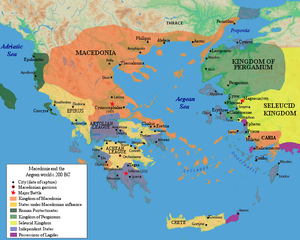Battle of Cynoscephalae
| Battle of Cynoscephalae | |||||||
|---|---|---|---|---|---|---|---|
| Part of the Second Macedonian War | |||||||
 A map showing the location of Cynoscephalae. |
|||||||
|
|||||||
| Belligerents | |||||||
|
Roman Republic Aetolian League allies |
Macedon | ||||||
| Commanders and leaders | |||||||
| T. Quinctius Flamininus | Philip V of Macedon | ||||||
| Strength | |||||||
| 22,000 infantry, 8,000 light infantry, 2,500 cavalry, and 20 war elephants 32,500 men total | 16,000 phalangites, 2,000 light infantry, 5,500 mercenaries and allies, and 2,000 cavalry, 25,500 total | ||||||
| Casualties and losses | |||||||
| about 700 killed and 2000 wounded | 8,000 killed, 5,000 captured | ||||||
The Battle of Cynoscephalae (Greek: Μάχη τῶν Κυνὸς Κεφαλῶν) was an encounter battle fought in Thessaly in 197 BC between the Roman army, led by Titus Quinctius Flamininus, and the Antigonid dynasty of Macedon, led by Philip V.
In 201 BC, Rome won the Second Punic War against Carthage. Philip V of Macedon had attacked Rome's client states in the Mediterranean for 20 years. The Greek city-states, led by Athens, appealed to Rome for help. In 197 BC the Roman army of Titus Quinctius Flamininus, with his allies from the Aetolian League, marched out towards Pherae in search of Philip, who was at Larissa.
Flamininus had about 25,500 men, thus subdivided: 20,000 legionary infantry, 2,000 light infantry, 2,500 cavalry and 20 war elephants; further it included soldiers from the allied Aetolian League, light infantry from Athamania, and mercenary archers from Crete.
Philip had about 27,000 men of which 16,000 were phalangites, 4,000 light infantry, 5,000 mercenaries and allies from Crete, Illyria, Thrace, plus 2,000 cavalry led by Heracleides of Gyrton.
During the march there was a heavy rainstorm, and the morning after there was a fog over the hills and fields separating both camps. Despite this, Philip resumed his march, and his troops became confused and disoriented due to heavy fog. Philip then sent a small force to take the Cynoscephalae hills (coordinates: 39º25'N, 22º34'E). Flamininus, still unaware of Philip's location, sent out some cavalry and light infantry to reconnoiter, which engaged Philip's troops on the hills. The battle on the hills grew fierce and Flamininus sent 500 cavalry and 2,000 infantry as reinforcements, mostly Aetolians, forcing Philip's men to withdraw further up the hill. Philip now sent more men into the melee, his Macedonian and Thessalian cavalry, who drove the Romans down the hill, until the Aetolian cavalry stabilized the situation. Philip, though reluctant to send his phalanx into the broken, hilly terrain eventually ordered an assault with half the phalanx, 8,000 men when he heard of the Roman retreat. Flamininus positioned his troops on the field as well. He left his right wing in reserve, with his elephants in front, and personally led the left wing against Philip. Meanwhile, Philip's phalanx had reached the summit, and after joining with their light troops and cavalry which he placed on his right wing, Philip had his phalanx charge down the hill into the oncoming legionaries. As the Roman left was slowly being driven back, Flamininus took command of his right and ordered an assault there.
...
Wikipedia
